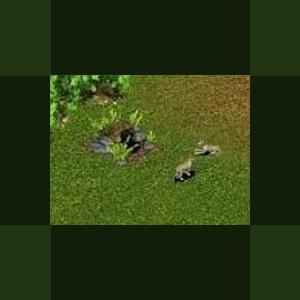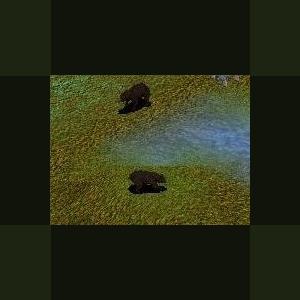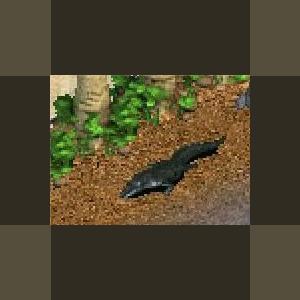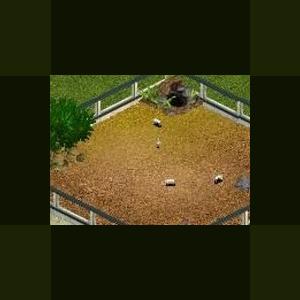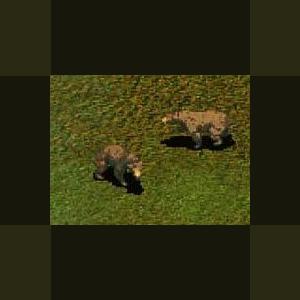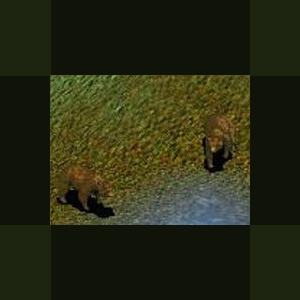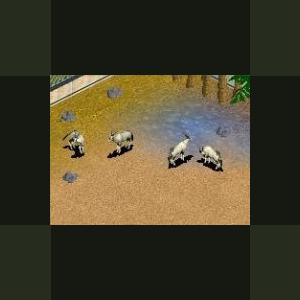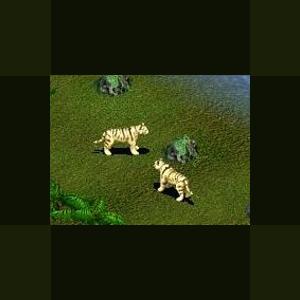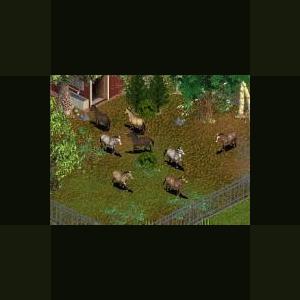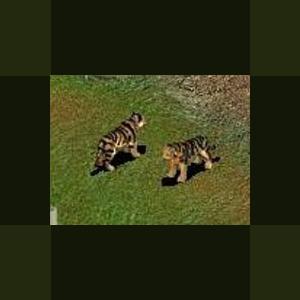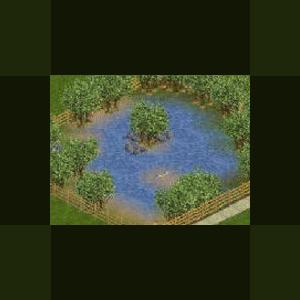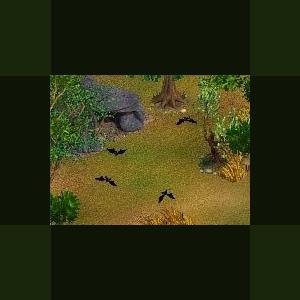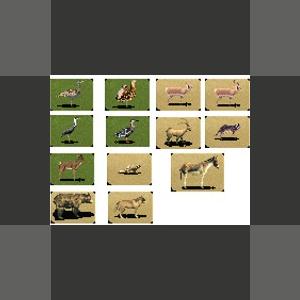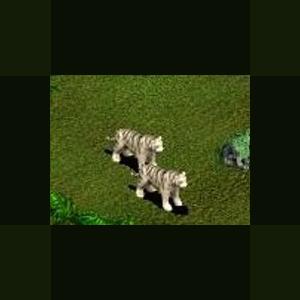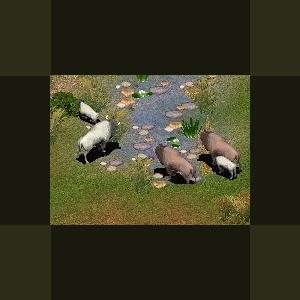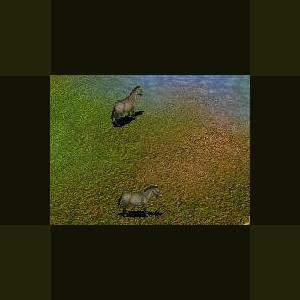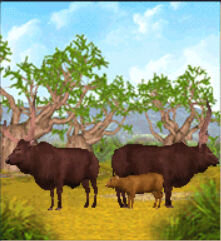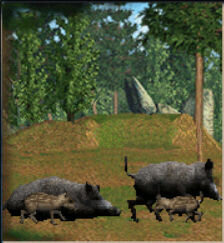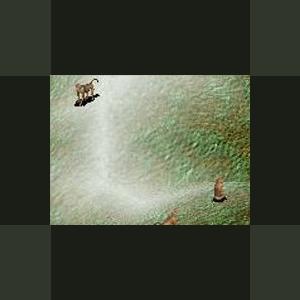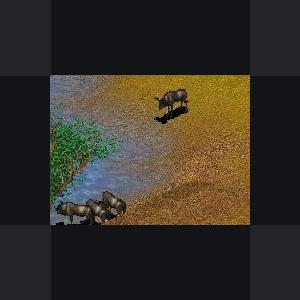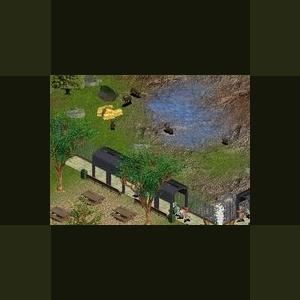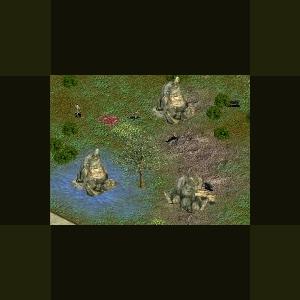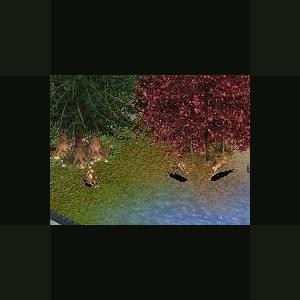279 files
-
Swift Fox by Ghirin
By Guest
The swift fox (Vulpes velox) is found in the open grasslands and dry regions of North America. It is nocturnal, preferring to stay in underground burrows during the day.
Swift foxes prey on rodents and rabbits and live in monogamous pairs.
Reference:
http://www.lioncrusher.com/animal.asp?animal=33
Created by Ghirin 2008
Updated 2010-11-06
Just to save space with less in zip and smaller image.
Nothing new.
306 downloads
0 comments
Updated
-
Cinnamon Bear by Ghirin
By Guest
A beautiful color phase of the black bear that will look great in any zoo.
Cinnamon bears prefer to live alone or in small groups.
Cinnamon bears like to sleep in rock caves.
Updated 2010-10-30
Just to save space with less in zip and smaller image.
Nothing new.
250 downloads
0 comments
Updated
-
Black Caiman by Ghirin
By Guest
The black caiman (Melanosuchus niger) is found throughout the Amazon River basin. Both hunting and loss of habitat have severely impacted the population.
References:
http://www.flmnh.ufl.edu/cnhc/csp_mnig.htm
www.wikipedia.com
Created by Ghirin 2008
Updated 2010-10-30
Just to save space with less in zip and smaller image.
587 downloads
0 comments
Updated
-
Naked Mole Rat by Jordan
By Guest
Naked Mole Rats are African rodents which live in burrows and can thrive in small exhibits.
Updated 2010-11-04
Just to save space with less in zip and smaller image.
Nothing new.
389 downloads
0 comments
Updated
-
Blond Bear by Ghirin
By Guest
The blond bear is a color phase of the American black bear. This particular color phase is most common in the western portion of North America and is thought to be due to the more open habitat of that region. Brown, black, and cinnamon “black” bears are also found in the same regions as blond bears.
Blond bears have the same habitat needs as regular black bears. It is compatible with black, cinnamon, and glacier phases of the American bear.
Updated 2010-10-30
Just to save space with less in zip and smaller image.
249 downloads
0 comments
Updated
-
Eurasian Brown Bear by Ghirin
By Guest
The Eurasian brown bear is the Old World population of Ursus arctos, equivalent to the grizzly and Kodiak bears of North America. These bears have considerable size range, from the small bear of southern Europe to the giant bears of the Kamchatka peninsula (eastern Siberia). Likewise, the fur has a wide range of color, from blonde to almost black.
The brown bear has adapted to many of the habitats found on the Eurasian continent, including the dry environment of the Gobi desert and the mountain ranges of southern Asia. Populations have been recorded in Russia, Scandinavia, Eastern Europe, China, the Himalayas, Turkey, and Hokkaido. Small, isolated populations have also been found in continental Western Europe.
Brown bears have a varied diet. They usually eat what is most available at the time. Spring foods include grasses, sedges, moss and roots while later in the year, berries become more important. Other foods such as insects, fungi, and meat are eaten when available. In areas where there are salmon runs, bears will harvest salmon as the fish make their way up rivers to spawn.
Late fall is the time that brown bears seek out dens for hibernation. The bear might dig its own den, and then make a bed of dry vegetation. During hibernation, there is a significant depression in the bear's hear rate and respiration. However the bear can be easily roused if it needs to escape from danger.
Created by Ghirin 2003
Updated 2010-11-03
Just to save space with less in zip and smaller image.
Nothing new.
329 downloads
0 comments
Updated
-
Arabian Oryx by Jordan
By Guest
Arabian Oryx by Jordan
The Arabian Oryx is a highly endangered antelope living in the barren steppes, semi-deserts, and deserts of the Arabian peninsula. Only a few hundred remain in the wild.
Updated 2010-10-30
Just to save space with less in zip and smaller image.
Nothing new.
438 downloads
0 comments
Updated
-
Bali Tiger by Moondawg
By Guest
Bali Tiger by Moondawg 2009
The Bali Tiger (Panthera tigris balica), harimau Bali in Indonesian, or referred to as samong in archaic Balinese language, is an extinct subspecies of tiger found solely on the small Indonesian island of Bali. This was one of three sub-species of tiger found in Indonesia along with the Javan tiger (also extinct) and Sumatran tiger (critically endangered).
It was the smallest of the tiger sub-species; the sub-species was declared extinct on September 27, 1937 after a tigress was shot at Sumbar Kima, west Bali. Given the small size of the island, and limited forest cover, the original population could never have been large, and it is considered unlikely that any survive today.
The subspecies became extinct due to habitat loss and hunting.
Weight
This subspecies was the lesser sized of all tigers, rather comparable with the African leopard or North American cougar in size.
The weight of a male tiger was usually 90-100 kg (198-221 pounds).
Females weighed in at 65-80 kg (142-175 pounds).
Length
A male Bali tiger's length was around 7'-4" to 7'-7".
A female's length was around 6'-3" to 6'-5".
Appearance
Bali tigers had short fur that was deep orange colored and darker, fewer stripes than other tiger sub-species. Occasionally, between the stripes, there were small black spots. Bali tigers also had unusual bar-shaped patterns on the head.
Life
Balinese tigers lived up to approximately 8-10 years of age.
Prey/Predators
The only known predators of Bali tigers were humans. Like all tigers, the Bali tigers were carnivorous. The Bali tigers preyed upon most mammals that lived within their habitat.
Cubs
Female Bali tigers, after mating, had a gestation period of 103 days on average. They begat two or three cubs each mating, and the cubs weighed two or three pounds at birth. They were born blind. Cubs became weaned at around one year of age, and were fully independent at 18 months to two years of age. Sometimes the cubs stayed with their mother for another year.
Documentation, hunting and tiger culture in Bali
In Balinese culture, the tiger had a special place in folk tales and traditional arts, like the Kamasan paintings of Klungkung kingdom. However, they were perceived as a destructive force and depredation efforts were encouraged all the way to the time of extinction. Very few reliable accounts of encounters and even less visual documentations remain. One the most complete recordings was made by the Hungarian baron Oszkár Vojnich, who trapped, hunted and even took photos of a Balinese tiger. On November 3, 1911 he shot dead an adult specimen in the northwest region, between Gunung Gondol and Banyupoh River, documenting it in his book "In The East Indian Archipelago", Budapest 1913. [4] According to the same book, the preferred method of hunting tigers in the island was catching them with a concealed, large and heavy steel foot trap over bait (goat or muntjak) and then dispatching it with a firearm at close quarters.
As in this example, a final blow to the ever low numbers of island's tiger population was during the Dutch colonial period, when shikari hunting trips were conducted by European sportsmen coming from Java Island, armed with high power rifles and Victorian Era romantic but disastrous hunting mentality, like Surabayan gunmaker E. Munaut, who is confirmed with killing over twenty tigers in Bali, over few years span.
The last confirmed tiger was an adult female, killed on Sep. 27, 1937 at Sumbar Kima, western Bali; since then, claims of sighting were made, but without proof, mostly by forestry officers in years 1952, 1970 and 1972. The last remaining tigers were pushed into western side, mostly into area that is now Bali Barat National Park, established for but too late to save the tigers, in 1947, but not too late for other endangered animals like the endemic Bali starling (Leucopsar rothschildi). Chances tigers survived without being observed are virtually impossible with the publicity, technology and growth of population and mass tourism in this island today.
The Balinese tiger, sadly, never got to be captured on film alive, on motion picture or displayed in a public zoo, but few skulls, skins and bones are preserved in museums. British Museum in London has the largest collection with two skins and three skulls, others include Senckenberg Museum in Frankfurt, Naturkunde Museum in Stuttgart, Naturalis museum in Leiden and Zoological Museum of Bogor, Indonesia, who owns the remnants of the last known Balinese tiger ; in 1997 a skull emerged from the old collection of Hungarian Natural History Museum and was scientifically studied and properly documented.
Unlike stag hunting, which they mastered, very few if any Balinese launched into stalking tiger, whom aside from danger, was shone upon by malefic superstitions. Still, tigers had a well defined position in folkloric beliefs and magic. For example, the Balinese considered ground powdered tiger whiskers to be a potent and undetectable poison for one's foe. According to the same book mentioning this, Miguel Covarrubias "Island Of The Gods", 1937, when a Balinese baby was born he was given a protective amulet necklace with black coral and "a tiger's tooth or a piece of tiger bone".
Like other Asian nations, many Balinese people are fond of wearing tiger parts jewelry, for status or spiritual reasons like power and protection and necklaces of teeth and claws or male rings cabochoned with polished tiger tooth ivory still exist on everyday use. As tiger population disappeared on both Bali and neighboring Java, old parts are recycled or leopard and sun bear parts are used instead.
Updated 2010-10-30
Just to save space with less in zip and smaller image.
Nothing new.
605 downloads
0 comments
Updated
-
European Horse Pack singles by Genkicoll
By Guest
Four European horses made to be compatible with the Forest Tarpan by Ghirin.
Turkmen Akhal-Teke Horse
The Akhal-Teke horse breed (pronounced Ah-cull Tek-y) is a breed from Turkmenistan, where they are the national emblem. It is named after the nomadic tribe that bred them. They are racehorses, noted for their endurance on long marches and are thought to be the predecessors of the Arabian and English thoroughbred breeds. These beautiful "golden-horses' are adapted to severe climate conditions and are thought to be one of the oldest surviving horse breeds. There are currently about 3,500 Akhal-Tekes in the world, mostly in Turkmenistan and Russia, although they are also seen in Germany and the United States.
Alexander the Great's horse, Bucephalus, is said to have been an Akhal-Teke.
Breed characteristics
The Akhal-Teke's most notable and defining characteristic is the natural metallic bloom of its coat. This is especially seen in the palominos and buckskins, as well as the lighter bays, although some horses "shimmer" more than others, and is thought to have been used as camouflage in the desert, where the heat causes the desrt to shimmer. Also noteworthy are the breed's almond-shaped eyes. The breed is very tough and resilient, due to the harshness of the Turkmenistan lands, living without much food or water. This has also made the horses good for sport. The breed has great endurance, shown in 1935 when a group of Turkmenian horsemen rode the 2500 mile journey from Ashgabat to Moscow, which lasted 84 days, and included a 3 day desert crossing of 235 miles without water.
The horses have a fine head with a straight or slightly convex profile, and long ears. The mane and tail is usually sparse. Their long back has little muscle, and is coupled to a flat croup and long, upright neck. The Akhal-Teke possesses a sloping shoulder and thin skin. These horses have strong, tough, but fine limbs, although the hind legs are sometimes sickle-hocked. They have a rather shallow body with a shallow ribcage (like an equine greyhound), although a deep chest, and this shallowness continues to the back of the frame. The conformation is not considered "good" by Western terms, but that is made up by the breed's great beauty, and tremendous athletic ability.
The Akhal-Tekes are brave riding horses, lively, and alert, but are known to be obstinant and rebellious at times. They are generally a one-rider horse.
The horses are usually a pale golden color (like honey) with black points. They can also be bay, black, chestnut, or gray. The Akhal-Teke usually stands between 14.3 and 15.2 hh.
Chestnut Goklan Horse
The Goklan horse is, with the exception of the Yabou, the "heaviest" descendant of the old Turanian horse. He was bred in the main by the Goklan Turkoman, whose tribal borders are within Iran. As a result of the needs they had for their horse, the horse is well suited to mountainous terrain.
Breeders of Turkomans in Iran note that some Akhal-Teke foundation sires bear a strong resemblance to the Goklan horse they breed today. Curiously enough, some Arabian horses also bear a strong resemblance to the Goklan: the famous Polish Arabian sire Wielki Szelm (left) bears a very strong resemblance to Akhal-Teke foundation sire Dor Bairam (right). The Arabian has a higher tail-set and shorter back, accommodations to their differing terrain. Otherwise, in overall conformation, they are both much like a heavyweight Thoroughbred hunter.
Russian Arabian Dun Horse
The modern Russian Arabian breeding program was thus begun in 1930 at Tersk. Ever since the stud has accumulated much experience and produced dozens of superb individuals.
In 1930 the gray Koheilan IV was bought in Hungary, and from France came six pure–blood Arabian mares and a stallion. In 1939 from England came 6 Arabian stallions and 19 mares.
In 1939 a large group of Arabians arrived from Poland, and 9 more Arabian mares from Germany were added to the Tersk stock in 1947.
In March 1976 a WAHO commission visited Tersk. It confirmed the high quality of the stock there and recognized the pure–blood origins of all the horses except for Amara and Basma imported from Egypt in 1973.
In 1986 some stock was transferred to Khrenovoe, the stud founded by Count Orlov. The Arabian department at Khrenovoe is quite successful. The Khrenovoe horses compete with the Tersk Arabians on the track.
White Yabou Horse
The Yabou (sometimes spelled "yaboo") is the pack horse of the peoples on the Turkoman steppes. Some older references use "Yabou" in terms of "the horse of the people, a pack horse, a nag," but the Yabou is much more than that. The Yabou is every bit as hardy and enduring as the other Turkoman strains, and differs from them only slightly. There is a copious mane to go with the generous tail. The neck is set on lower than that of the Teke, Yamout or Goklan. The horse is somewhat less narrow than other Turkomans, and typically shorter. The shoulders especially are powerful. All in all, this is a horse built to carry weight over a distance, at speed. (Sometimes his job was to run behind the Turkomen horses, carrying their heavy felts). He often ambles and paces with fantastic speed.
Preliminary blood test results performed at the University of Kentucky show that the English Thoroughbred is more closely related to the Yabou than to either the other Turkoman breeds/strains or the Arabian in terms of shared genetic markers. That this ubiquitous "utility" horse would have a closer association to the Thoroughbred than other "thoroughbred" horses has come as somewhat of a surprise, but perhaps it should not. From the photo above (taken by Farshad Maloufi and used here with his permission), one can see that the Yabou is not at all lacking in quality.
The Yabou comes in the complete range of colors found in the Turkoman and Caspian horse.
The Turkoman do not breed Yabous themselves, although they use them extensively for pack horses. Rather, they buy them from gypsies who live in the more forested areas of the mountains. The Yabou probably always shared the range of the Turanian Thoroughbred, and was much more numerous; the Pazyryk kurgans each contain only a single Turanian but as many as a dozen or more Yabous.
Updated 2010-11-03
Just to save space with less in zip and smaller image.
Nothing new
503 downloads
0 comments
Updated
-
Trinil Tiger by Moondawg
By Guest
Trinil Tiger
The Trinil Tiger (Panthera tigris trinilensis) is a fossil tiger dating from about 1.2 million years ago. This tiger was found at the locality of Trinil, Java, Indonesia. These fossils are now stored in the Dubois Collection of the National Museum of Natural History in Leiden, the Netherlands. Although these fossils have been found on Java, the Trinil tiger is probably not a direct ancestor of the Javan tiger. The Trinil Tiger probably became extinct fifty thousand years ago.
Updated 2010-11-11
Just to save space with less in zip and smaller image.
Nothing new.
369 downloads
0 comments
Updated
-
Dragonfly by African Raptor
By Guest
Dragonfly is a kind of insect. It belongs to the Order Odonata and the Class Insecta. The family is True bugs. Given its large claw-like pinchers, the dragonfly is a predator and feeds on other organisms.
You can recognize a dragonfly nymph by its teardrop shaped abdomen. It also has very large eyes.
There are about 5,300 species of dragonflies around the world. It is an insect that has two pairs of thick and long wings.
It lives near fresh water (usually slow moving) and swamps. It spends its childhood in water. Dragonflies are not harmful to people, though are smart hunters. They can fly up to 60 mph and live for 2-5 years average.
For four years, dragonflies are in a young time when they live under the water. For one year they are an adult dragonfly.
Dragonflies have been around for 300 million years. In old prehistoric times dragonflies had wings that were over two feet wide.
Dragonflies can eat water insects as larvae, but as they grow older they eat tadpoles, small fish (really small fish), and even their own species.
Updated 2010-10-30
Just to save space with less in zip and smaller image.
Nothing new.
386 downloads
0 comments
Updated
-
Pemba Flying Fox by Genkicoll
By Guest
The Pemba flying fox is a large fruit bat weighing 400 - 650 g (0.9 - 1.4 lb). Its diet consists of the fruit and flowers of a number of plants.
Primary and secondary forest, graveyards and mangroves provide roosting sites. The Pemba flying fox is very social and has been found in large colonies until recently.
The Pemba flying fox is found only on Pemba Island, Tanzania. The island was originally forested, but only remnants of the primary forest remain. Estimates of the status of the Pemba flying fox have varied considerably recently. Studies in 1989 suggested a dramatic population decline, with fewer than 10 individuals being seen, and the species was considered to be on the brink of extinction. However, in 1992, surveys indicated a population in the region of 2400-3600, although it was estimated that the population may have declined significantly in the preceding decade. (Entwistle & Corp 1997)
Habitat loss from deforestation is a major concern, since the last fragments of natural forest are now in danger of disappearing (Seehausen 1991). Pemba islanders hunt bats only for subsistence purposes, not for commercial purposes. Currently, the villagers appear mainly to use traditional hunting methods. If the use of shotguns increases, hunting could become more of a threat.
Source: Professor Paul's Nature Encyclopedia
Many thanks to Ziggy for the original gif animations.
Updated 2010-11-05
Just to save space with less in zip and smaller image.
Nothing new.
490 downloads
Updated
-
Gobi Pack by And 1
By Guest
Pack which contain 11 animals from the Gobi / Mongolian Area. Made by And 1
The Gobi pack contains 11 animals from the Gobi/ Mongolian area:
Gobi Kulan (German: Gobi Halbesel)
Gobi Bear (German: Gobi Bär)
Gobi Wolf (German: Gobi Wüsten Wolf)
Siberian Ibex(German: Sibirische Steinbock)
Mongolian Gazelle (German: Mongolische Gazelle)
Hooded Crane (German: Mönchskranich)
Przewalski's Gazelle (German: Przewalski Gazelle)
Marbled Polecat (German: Tigeriltis)
Chinese Mountain Cat (German: Gobikatze)
Great Bustard (German: Großtrappe)
Swane Goose (German: Schwanengans)
Files are in both German and English
UPDATED 12/20/2008 to correct the file format.
(German)
Updated 2010-11-03
Just to save space with less in zip and smaller image.
Nothing new
11 Nov 2012. Some players have noted that the bear does not appear ingame and this is how to fix it.
Note from Jay re the Gobi bear:
I put And_1_Gobi Bär.ZTD in my dlupdate folder without anything else and it did not appear in the animal purchase menu. I had to change the "ä" to "a" in the ".ztd" name to get it to appear in the animal purchase menu. I assume that it does appear in And_1's ZT, so it might have to do with the language used by each person's MS Windows.
1,347 downloads
Updated
-
Javan Tiger by Moondawg
By Guest
The Javan tiger (Panthera tigris sondaica) was a tiger limited to the Indonesian island of Java.
It now seems likely that this subspecies was made extinct in the 1980s, as a result of hunting and habitat destruction, but the extinction of this subspecies became increasingly probable from the 1950s onwards, when it is thought that fewer than 25 tigers remained in the wild. The last specimen was sighted in 1972. A track count in 1979 concluded that three of the tigers were in existence. However it is possible that it is not extinct, as in the 1990s, there were some unverified reports of sightings.
By 1940, the Javan tiger had been pushed into remote mountain ranges and forests. Some small reserves were set up, but were not large enough, and the quantity of prey species were too low. By the mid-1950s, 20-25 tigers remained on Java. Half of these were in the well-known Ujong Kulon Wildlife Reserve, but the 1960s saw all tigers eliminated from this area and also from Baluran National Park. By 1972, the Javan tiger count was down to a maximum of seven in the newly-formed Meru Betiri Forest Reserve, and perhaps five elsewhere. Meru Betiri was rugged and considered this tiger's last chance for survival. However, even as it was declared a reserve, the area was under attack by agricultural development. A 1979 census located the tracks of only three tigers. Substantiated evidence that this tiger is still alive has not been forthcoming since then. The exact time of extinction remains unknown, but this was probably sometime in the mid-1980s.
Javan tigers were very small compared to other subspecies. Males were between 100 kg (220 lb) and 141 kg (310 lb) on average and around 2.45 m (8.0 ft) in length. Females weighed between 75 kg (170 lb) and 115 kg (250 lb) on average and are smaller than males in length.
Occasional reports still surface of a few tigers to be found in east Java where the forested areas account for almost thirty percent of the land surface. Meru Betiri National Park, the least accessible area of the island, is located here and considered the most likely area for any remaining Javan tigers. This park is now coming under threat from three gold mining companies after the discovery of 80,000 tons of gold deposit within the locality.
Despite the continuing claims of sightings it is far more likely that, even with full protection and in reserve areas, the Javan tiger was unable to be saved. The 'tigers' are quite likely to be leopards seen from a distance.
At the present time the World Conservation Monitoring Centre lists this subspecies as having an 'outstanding query over status' rather than 'extinct', and some agencies are carrying out experiments using infrared activated remote cameras in an effort to photograph any tigers. Authorities are even prepared to initiate the move of several thousand people should tiger protection require this.
But until concrete evidence can be produced (expert sightings, pug marks, photographic evidence, attacks on people and animals), the Javan tiger must be considered yet another tiger subspecies which is probably extinct.
In November 2008, an unidentified body of a female mountain hiker was found in Mount Merbabu National Park, Central Java, allegedly died from tiger attack. Villagers who discovered the body has also claimed some tiger sightings in the vicinity.
Updated 2010-11-03
Just to save space with less in zip and smaller image.
Nothing new.
402 downloads
0 comments
Updated
-
Buffalo and White Buffalo by Genkicoll
By Guest
These buffalo are very happy in the same exhibit, which is more visually interesting than the in-game bison's exhibit. You can now add wallows or a few hills if you like, as well.
Buffalo
The largest mammal on the North American continent, a healthy adult buffalo needs to have little fear of predators. However, a peacefully grazing animal can change without warning into a snorting, pawing, 2,000-pound threat, with a menacingly lowered head and stiffly upraised tail. Buffalo can charge at speeds over 30 mph. Both male and female buffalo have massive heads, which are not only equipped with lethal horns, but are also effective as battering rams.
Buffalo at rest may be seen rolling and wallowing. Wallows created by buffalo are shallow, dust-filled depressions, and were once a common feature of the plains where they roamed in large numbers. Buffalo live near gravel-lined streams amongst the gently rolling hills and plains of Northern America.
White Buffalo
The Legend of the White Buffalo:
"One summer a long time ago, the seven sacred council fires of the Lakota Sioux came together and camped. The sun was strong and the people were starving for there was no game.
Two young men went out to hunt. Along the way, the two men met a beautiful young woman dressed in white who floated as she walked. One man had bad desires for the woman and tried to touch her, but was consumed by a cloud and turned into a pile of bones.
The woman spoke to the second young man and said, "Return to your people and tell them I am coming." This holy woman brought a wrapped bundle to the people. She unwrapped the bundle giving to the people a sacred pipe and teaching them how to use it to pray. "With this holy pipe, you will walk like a living prayer," she said. The holy woman told the Sioux about the value of the buffalo, the women and the children. "You are from Mother Earth," she told the women, "What you are doing is as great as the warriors do."
Before she left, she told the people she would return. As she walked away, she rolled over four times, turning into a white female buffalo calf. It is said after that day the Lakota honored their pipe, and buffalo were plentiful." - from John Lame Deer's telling in 1967
These animals are fully compatible, and are programmed to like Catfish's small stones, Paardjee's green grass, Sundance's prairie foliage (not released yet), and several user-made shelters. These animals do NOT need a shelter, but they won't object to having one, either. Also shown in screenshot are some of Genki's Tall Grasses, which are exhibit-neutral.
UPDATED October 15, 2008 to make compatible with Genki's Night Mare and Day Mare, to fix a small error in the .ucs, and to make the buffalo like exhibit-neutral items.
Updated 2010-10-30
Just to save space with less in zip and smaller image.
673 downloads
Updated
-
Forest Tarpan by Ghirin
By Guest
Forest Tarpan
Author: Ghirin
The tarpan (Equus caballus gmelini) was the wild horse of Europe and western Asia. There were two basic types: forest and steppe. The forest tarpan was a bit smaller than its steppe counterpart and darker in color. The tarpan is believed to the ancestor of modern light horse breeds.
The forest tarpan lived in most of Europe, dwelling in the forested areas. It became extinct as farmers converted its habitat to farmland and killed tarpans because tarpan stallions would steal domesticated mares for the wild herds. The original wild tarpan died out in the late 1800s.
Two attempts have been made to reconstruct the tarpan from animals of mixed tarpan and domestic background. In Poland, the government has established a feral herd of horses descended from mixed stock in the forest preserve of Bialowieza. With each generation, this herd seems to display more tarpan-like characteristics. The second attempt was by German zoologists. They used primitive breeds of European horses to produce a tarpan-like horse.
The classic features of the forest tarpan include a mouse-dun color with a black stripe down the center of the back and dark legs, semi-erect mane, large head with massive jaws, a thick neck, and tough hooves that do not need to be shod.
Created by Ghirin 2003
Updated 2010-11-03
Just to save space with less in zip and smaller image.
Nothing new
248 downloads
0 comments
Updated
-
Water Buffalo by Khaydar
By Khaydar
Adopt a Water Buffalo (Bubalus arnee) for your zoos.
Water Buffalo description:
Minimum happiness needed for chance of breeding: 90.
Liked foliage:
Rainforest Fern, Mangrove Tree
Liked rock:
Large Rock, Small Rock - Medium, Small Rock - Small
Animal can jump.
Number of animals allowed per exhibit: 3-15 with 20 squares each.
A suitable exhibit for 3 of this animal has 60 squares containing terrain of:
24 Rainforest Floor, 12 Dirt, 12 Grass, 12 Fresh Water
using 7 grid squares filled with 4 Mangrove Tree most liked plant
and using 5 Small Rock - Small most liked rock.
Preferred shelter: Large Stable.
Credits to DutchDesigns for the model
Made by Khaydar
186 downloads
- living animal
- bovid
- (and 1 more)
0 comments
Updated
-
Watusi Cattle by Khaydar
By Khaydar
Adopt a Watusi (Bos taurus africanus) for your zoos.
Watusi description:
Minimum happiness needed for chance of breeding: 90.
Liked foliage:
Tall Grass, Savannah foliage
Animal can jump.
Number of animals allowed per exhibit: 4-15 with 20 squares each.
A suitable exhibit for 4 of this animal has 80 squares containing terrain of:
64 Savannah Grass, 8 Dirt, 8 Fresh Water
using 10 grid squares filled with 4 Tall Grass most liked plant
and 6 small rocks.
Preferred shelter: Large Stable.
Credits to DutchDesigns for the model and mesh
Made by Khaydar
168 downloads
- living animal
- bovid
- (and 1 more)
0 comments
Updated
-
White Rhinoceros by Khaydar
By Khaydar
Adopt a White Rhinoceros (Ceratotherium simum) for your zoos.
White Rhinoceros description:
Minimum happiness needed for chance of breeding: 90.
Liked foliage:
Thorn Bush, Umbrella Thorn Tree, Tall Grass
Liked rock:
Large Rock, Small Rock - Medium, Small Rock - Small
Number of animals allowed per exhibit: 1-10 with 50 squares each.
A suitable exhibit for 2 of this animal has 100 squares containing terrain of:
60 Savannah Grass, 10 Sand, 25 Dirt, 5 Fresh Water
using 9 grid squares filled with 4 Tall Grass most liked plant
and using 8 Small Rock - Small most liked rock.
Preferred shelter: Large Stable.
Credits to DutchDesigns for the model and mesh
Made by Khaydar
291 downloads
- living animal
- rhinoceros
- (and 1 more)
Updated
-
Wild Boar by Khaydar
By Khaydar
Adopt a Wild Boar (Sus scrofa) to your zoos.
Wild Boar description:
Minimum happiness needed for chance of breeding: 90.
Liked foliage:
Weeping Willow Tree, White Oak Tree
Liked rock:
Large Rock, Small Rock - Medium, Small Rock - Small
Number of animals allowed per exhibit: 2-6 with 12 squares each.
A suitable exhibit for 2 of this animal has 24 squares containing terrain of:
11 Deciduous Floor, 2 Dirt, 1 Fresh Water, 4 Grass, 6 Coniferous Floor
using 10 grid squares filled with 4 Weeping Willow Tree most liked plant
and using 6 Small Rock - Small most liked rock.
Preferred shelter: Large Burrow.
Credits to Hendrix for the model and mesh
Made by Khaydar
225 downloads
- living animal
- pig
- (and 1 more)
0 comments
Updated
-
Highland Rhesus Macaque by Ghirin
By Guest
Highland Rhesus Macaque
Author: Ghirin
Rhesus macaques (Macaca mulatta) are very adaptable primates and have a wide range in southern Asia. They have been reported in habitats ranging from sea level to elevations of 2500 meters, including snow, intense heat, near-desert, dense forests and cities.
They will eat a wide variety of foods, including fruit, vegetation, eggs, small animals, insects, crops and assorted human foodstuffs.
Highland rhesus macaques dwell in the countries of Nepal, China, India, and Pakistan.
Created by Ghirin 2003
Updated 2010-11-03
Just to save space with less in zip and smaller image.
Nothing new
323 downloads
0 comments
Updated
-
Black Wildebeast by G2K
By Guest
Black Wildebeast
Author: G2K
The black wildebeest is dark brown to black in color, males being darker in color than females. Both sexes become lighter in coat color in the summer, and develop shaggier coats in the winter. Like the common wildebeest, Connochaetes taurinus, Connochaetes gnou possesses a bushy beard and mane.
Updated 2010-10-30
Just to save space with less in zip and smaller image.
UPDATED July 25, 2009 by genki to fix the following:
- Fixed LCID error, which can cause some people's games to crash.
- Linked to in-game sounds and removed extra, unneeded sounds.
- Cleaned up .uca and fixed some problems that were coming up on the .uca checker.
Update 8 August 2013 to reupload the updated file because the old file was uploaded in 2010 by mistake.
296 downloads
0 comments
Updated
-
Alpine Ibex by Paardjee
By Guest
Alpine Ibex by Paardjee
A different species of ibex for in your zoo.
Alpine ibexes are very cheerfull and lively they'll make your guests very happy
The Alpine Ibex (Capra ibex) commonly called by its French name: bouquetin, by its German name: steinbock, by its Dutch name: steenbok, by its Slovenian name: kozorog, or by its Latin nickname: capricorn—is the species of ibex that lives in the European Alps. The Spanish Ibex (Capra pyrenaica) and the Middle Eastern Nubian Ibex (Capra ibex nubiana) are very close relatives of the Alpine Ibex — the Spanish form is generally considered specifically distinct, but the Nubian is usually considered a subspecies of Alpine Ibex.
Habitat
Being an excellent climber, its habitat is the rocky region along the snowline above alpine forests of the European Alps. They tend to occupy steep, rough terrain at elevations of 6,500–15,000 feet.
Appearance
Male specimens commonly grow to a height of about 1 metre (3 feet) and reach a weight of about 100 kg (220 lb). Females are usually only half the size of males. Apart from size, males can also be distinguished by their prominent beard. Older males will tend to grow beards under their chin. Both male and female ibexes have large, backwards-curving horns although those of the male are substantially larger and can grow to an impressive length of up to 1 m. These horns are used to defend themselves from predators such as wolves, lynxes, bears and foxes. Small kids may also be susceptible to attacks from large predatory birds such as eagles. The Ibex has a brownish grey colouring in the summer which changes during the winter months to a richer, darker brown. It is related to the Nubian and Siberian ibexes.
Foraging behaviour
Ibexes are strictly herbivorous and survive on a diet of grass, moss, flowers, leaves and twigs. If leaves and shoots are out of reach, Ibexes often stand on their rear legs to reach this food. They eat during late afternoon and evening hours, descending at this time from the high steep cliffs and into the lower alpine meadows below. The rest of the day is spent in the higher altitude of the cliffs and hills. This pattern of remaining at higher altitudes during the bright daylight hours helps protect them from predators who do not inhabit such high terrain. In the winter, Ibexes also tend to live at lower altitudes since food is more scarce. The need to drink every few days in the summer causes the Ibexes to seek permanent residence within proximity to a dependable water source during this season. If predators are after them, Ibexes will hide in the rocks of the steep cliffs.
Updated 2010-10-30
Just to save space with less in zip and smaller image.
Nothing new.
334 downloads
0 comments
Updated
-
British Wilderness Pack by G2K
By Guest
This great pack has three animals: the red fox, Black Scottish Cat, and a Scottish Cat, a rock, grass, and gorse.
Scottish Wild Cats are found in the forests and open areas of Scotland and north England.
Red Foxes are found worldwide in a variety of habitats.
Black Scottish wild cats are melanistic forms of scottish wild cats.
Also contains gorse, forest fern and a granite rock.
Updated 2010-10-30
Just to save space with less in zip and smaller image.
24 February 2013 to add the July 2009 update since unfortunately the wrong file was uploaded in 2010 when all files had to be reloaded. The January 2009 update was loaded instead of the July 2009 version.
Updated : Jan 7 2009, to adjust scenery
*UPDATED July 25, 2009 by Genki to fix the following:
- Fixed LCID errors, which can cause some people's games to crash.
- Linked to in-game sounds and removed extra, unneeded sounds.
- Cleaned up .uca and fixed some errors and warnings that were coming up on the .uca checker.
- Foliage (forest fern and gorse) adjusted to make them auto-rotate, and to adjust so that the guests can see over them.
760 downloads
0 comments
Updated
-
Japanese Macaque by Coolperson5
By Guest
Japanese Macaque by Coolperson5
The Japanese Macaque is the farthest northern living non-human primate. They are known for being very smart and copying humans.
Updated 2010-11-03
Just to save space with less in zip and smaller image.
Nothing new.
388 downloads
0 comments
Updated

